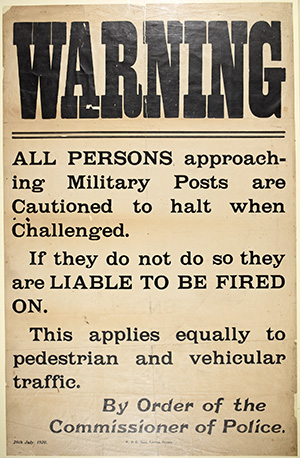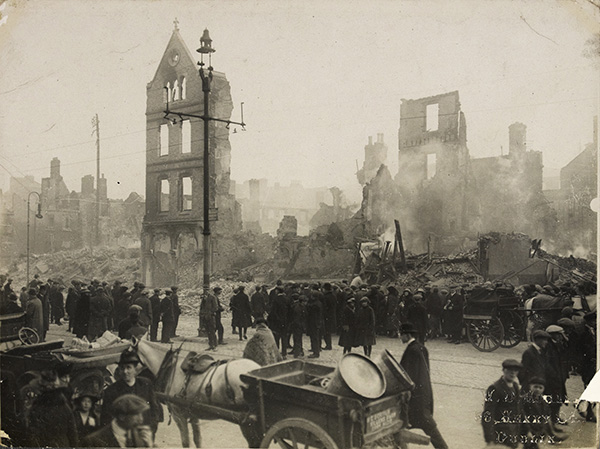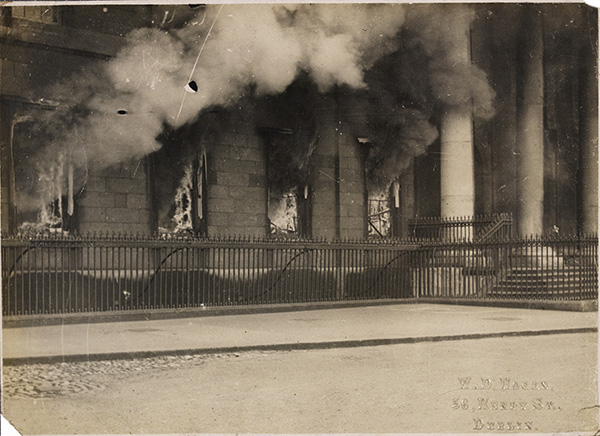MUSEUM EYE: From Turmoil to Truce—photographs of the War of Independence
Published in Issue 2 (March/April 2020), Reviews, Volume 28National Photographic Archive, Meeting House Square, Temple Bar
nli.ie
By Tony Canavan
 This exhibition explores aspects of the Irish War of Independence through photographs from the National Library’s collections with an accompanying programme of discussions, events and tours. The exhibition makes good use of the limited space in the Meeting House Square gallery and hardly a piece of wall is wasted. Along with the photographs there are interactive screens and videos. One large screen runs in a loop showing newsreel footage from this period.
This exhibition explores aspects of the Irish War of Independence through photographs from the National Library’s collections with an accompanying programme of discussions, events and tours. The exhibition makes good use of the limited space in the Meeting House Square gallery and hardly a piece of wall is wasted. Along with the photographs there are interactive screens and videos. One large screen runs in a loop showing newsreel footage from this period.
The tagline of this bilingual exhibition is ‘The images are black and white. The issues aren’t’. While this might be a good PR slogan, it hardly reflects the reality of the situation. The issue was black and white: either Ireland had the right to independence or it did not. I have mentioned before in relation to other State-sponsored exhibitions, such as the Garda Museum, that there seems to be a reluctance to acknowledge the revolutionary nature of the foundation of the Irish state, along with an attempt to portray independent Ireland as a continuation of what went before. The row in January over a proposed commemoration for the Royal Irish Constabulary was an illustration of how such an approach can backfire.
Having said that, while there are captions, the images largely speak for themselves. On entering one sees a large panel that gives the who, what and where of the war. This panel is dominated by the photograph of an Auxiliary in beret and greatcoat, armed with a revolver and a Lewis machine-gun, epitomising the popular image of these recruits sent to bolster the RIC. On the wall above is an enlarged photo of Black and Tans and Auxiliaries outside a house that has just survived an IRA attack (front cover and p. 51). They are all smiling young men in ragtag uniforms, many with the insignia of the units in which they had served during the First World War.
The photos come from a number of sources but attention is given to W.D. Hogan, described as a jobbing photographer, who worked in Dublin and covered events and incidents without favouring one side or the other. Many of the well-known images of the War of Independence are Hogan’s work. Given that the IRA was a guerrilla army, it is not surprising that most photographs are of the Crown forces. Often it is dead IRA members who feature in the photographs. Dáil Éireann did have a press department but it could not send out photographers to chronicle the war from the IRA’s perspective.
The images of the Crown forces—RIC, Black and Tans, Auxiliaries and regular troops—all show that the IRA faced a formidable, heavily armed force that travelled in lorries and armoured cars and was armed with an array of weapons. Nevertheless, there are plenty of photographs of IRA Volunteers. On the landing there is an enlarged picture of members of the 3rd Tipperary Brigade flying column. They are not so different from their opponents, being mostly young men in makeshift uniforms, although less heavily armed. This photo is in contrast to another large one of Dublin Castle officials—innocent enough until you see the annotations by an IRA officer marking out some of them for assassination.


Above: The exhibition covers major events such as the burning of Cork in December 1920 (Top) and the IRA attack on the Customs House in May 1921 (Bottom). (All images: NLI)
The exhibition covers major events such as the burning of Balbriggan and Cork and the IRA attack on the Customs House. Later, there are photographs of delegates at the discussions that led to the Truce, which ends the exhibition. While most of the photographs come from British and Irish sources, foreign newspapers also feature and show that there was sympathy for the Irish cause. This international interest led to British attempts to influence opinion through an early version of ‘fake news’. One example shows pictures from the Illustrated London News of the battle of Tralee, in which an outnumbered British patrol fought off an IRA attack, an incident also covered by Pathé News. There was no such ambush, however; it was a propaganda exercise with which some journalists went along.
One thing that struck me from these photos was that the war was fought against a backdrop of people trying to get on with their lives. If we look past the armed men and the bodies on the ground, we see shops advertising a sale, a cart delivering coal and even children playing in the street. If this is a reminder that not everyone supported the war, photographs of crowds cheering British officials illustrate that there were Irish people who supported British rule—and of course we cannot ignore the sizeable population of Ulster unionists who also feature.
The strength of this exhibition is the photographs speaking for themselves: we can literally look the participants in the eye and judge their demeanour. Despite attempts to balance the view of the war, it is clear that the IRA were a handful of lightly armed men taking on a larger, heavily armed force.
Tony Canavan is editor of Books Ireland.
















